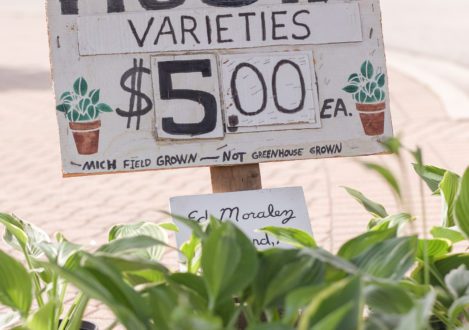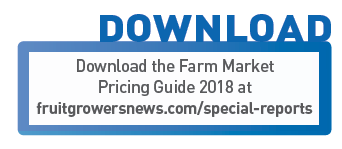

Aug 28, 2018Farm markets report prices, strategy


The biggest challenge of direct sales is the same as its biggest benefit: Setting your own price. Growers know what they are able to supply, but the difficulty at the market is setting a price point for optimal demand. Growers and direct farm marketers determine their prices through a variety of techniques, but most keep an eye on what other markets are doing.
This year, for the first time, Fruit Growers News also is watching farm markets – or rather, asking them. We conducted a national electronic survey of farm markets, asking them about how they set their prices, as well as their specific prices for a wide variety of crops and food products common in markets.
A total of 160 farm markets from 33 states responded to the survey questions.
Survey says …
Direct farm marketers are using a wide variety of techniques to determine their prices.
One New York state seller’s process of determining a price was self-described as “chaos” and “an expensive education.” However, many growers take a methodical or practical approach.
“I look at similar items selling in our area from several different sources,” a survey respondent from Montana wrote. “I then determine if our crops have any extra value such as peak ripeness, freshness or blemish free.”
For one Michigan seller, last year’s price is the starting point, “then it depends on the quality of the crop,” and calls out to other markets in order to stay competitive.
Other growers say they crunch the numbers.
“Try to figure the cost of production plus 50 percent,” a Vermont grower wrote. “Compare other farm prices, and check Vermont market summaries.”
Brian Moyer, a Penn State Extension program assistant, and columnist for Fruit Growers News, recommends growers calculate their costs before fixing prices.
“Producers need to know their cost of production,” he said. “I understand how difficult that can be given the variety of products but at the end of the season you should know what your basic break-even points are for your crops so you can price accordingly.”
Markup matters
Markups over cost or expenses range from 25-30 percent, reported by an Ohio grower, to a “minimum of 70 percent,” reported by a Pennsylvania grower.
Another Pennsylvania grower had a more simplistic formula for calculating price: Four times the price of the seed.
“Prices are determined by calculating our cost of production along with researching retail pricing of comparable products in our area,” an Indiana grower wrote.
Location, location
Many survey respondents said they also considered the prices at local supermarkets and big box stores.
“We don’t try to match grocery store pricing, but if we are cheaper than a store we will probably raise it,” a Wisconsin grower said. “We also won’t charge as high for donuts as our suburbs competitors because the prices they can command are higher than what is an acceptable price to the consumer in our area.”
Moyer said that location also matters in southeast Pennsylvania.
“The closer you get to a city like Philadelphia the more you can charge but your market costs will be higher as well in that location (parking, city licenses, etc.),” he said. “Market setting can impact what price you get but I’m not sure if it matters that it’s a public market, retail or roadside. I do see very experienced producers still basing their pricing on what their neighbor sells it for and what the grocery store sells it for.”
Money talks
Three out of four survey respondents are charging extra for premium crop varieties.
Honeycrisp apples dominated the premium apple varieties, as did its various family members: EverCrisp, CandyCrisp and SweeTango. Also among the premium apple varieties were Crimson Crisp, Jonagold, Macoun, Pixie Crunch, Tsugaru, Pink Lady, Senshu, Ambrosia, Cameo, GoldRush, Galaxy Gala, Ginger Gold, Zestar, Russet and antique apple varieties. Other premium fruit varieties included Albion strawberries, day-neutral strawberries, Saturn peaches and Asian pears.
Premium vegetable varieties included miniature varieties, extra-large beefsteak tomatoes, early season hoop house tomatoes, purple asparagus as opposed to green, exceptionally large or exotic pumpkins, heirloom varieties and Mirai white corn.
The range of added cost for premium products also varied. Using Honeycrisp as an example, sellers reported charging 20-50 percent more than more plentiful apple varieties.
– Stephen Kloosterman, FGN Associate Editor
Photo: Holland Farmers Market














